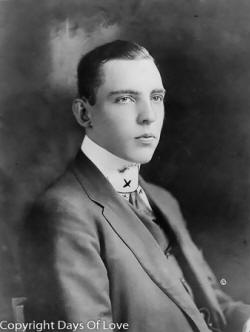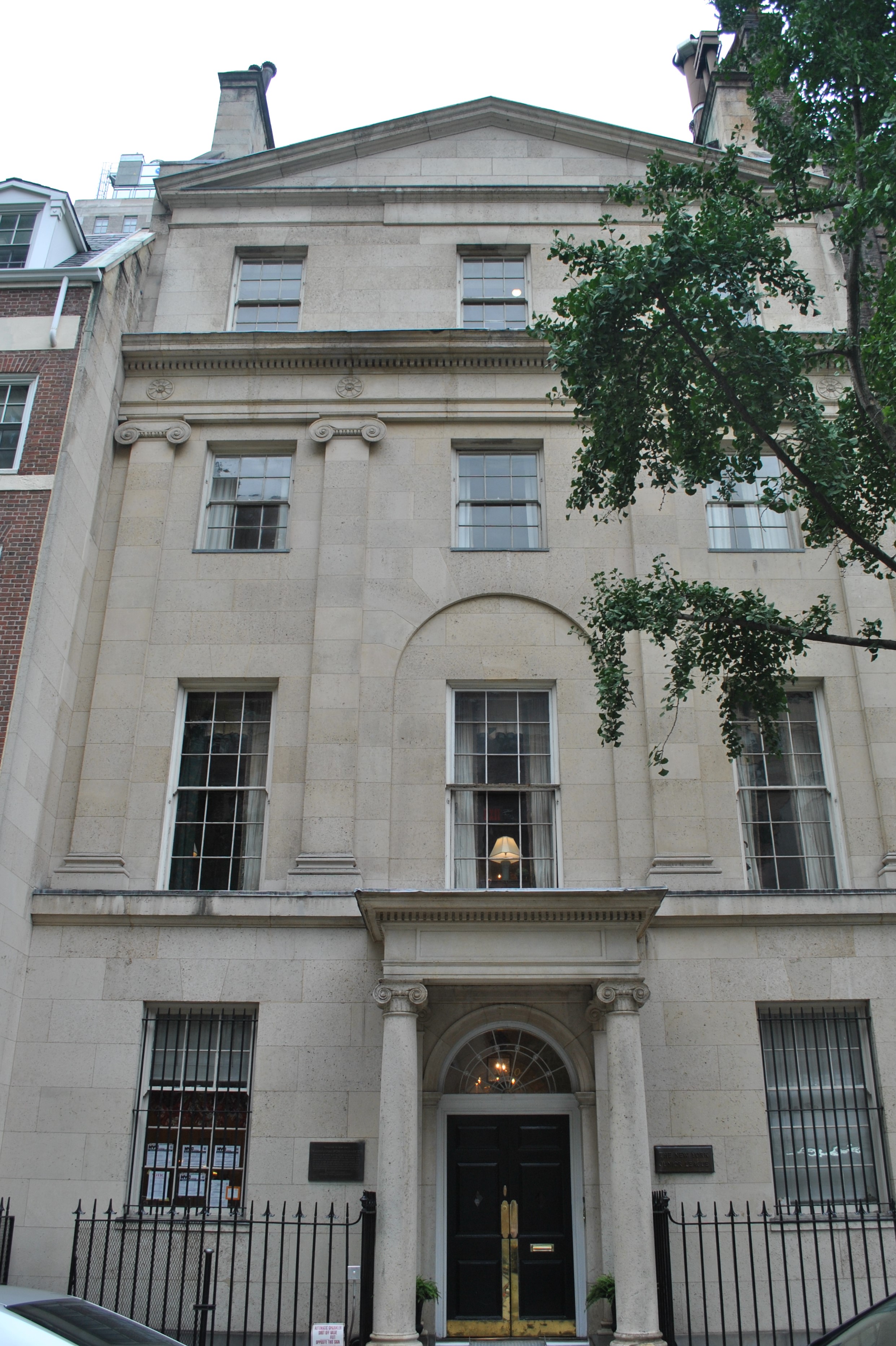Wife Helen Dinsmore Huntington, Mary Benedict Cushing
Queer Places:
Harvard University (Ivy League), 2 Kirkland St, Cambridge, MA 02138
Vincent Astor House, 130 E 80th St, New York, NY 10075, USA
Vincent Astor House, 120 East End Ave, New York, NY 10028, Stati Uniti
Sleepy Hollow Cemetery, 540 N Broadway, Sleepy Hollow, NY 10591, Stati Uniti
 William Vincent Astor[1] (November 15, 1891 – February 3, 1959) was a businessman, philanthropist, and member of the prominent Astor family.
William Vincent Astor[1] (November 15, 1891 – February 3, 1959) was a businessman, philanthropist, and member of the prominent Astor family.
Called Vincent, he was born in New York City on November 15, 1891. He was the son of John Jacob Astor IV, millionaire and inventor and his first wife, Ava Lowle Willing, an heiress from Philadelphia.
He graduated from St. George's School, in Middletown, Rhode Island, in 1910 and attended Harvard University from 1911 to 1912, leaving school without graduating.[2]
Like his father, Vincent belonged to the New York Society of Colonial Wars. He served as commodore of the New York Yacht Club from 1928 to 1930.
Astor was interested in trains. In the early 1930s, he established an estate in Bermuda which included a private narrow-gauge railway and union station with the Bermuda Railway. The estate is now divided between several private owners, none of whom are part of the Astor family. As recently as 1992, the remains of some of his rolling stock were visible.[3]
Vincent Astor was, according to Astor family biographer Derek Wilson, "a hitherto unknown phenomenon in America: an Astor with a highly developed social conscience." He was 20 when his father died and having inherited a massive fortune, Vincent Astor dropped out of Harvard University. He set about to change the family image from that of miserly, aloof slum landlords who enjoyed the good life at the expense of others. Over time, he sold off the family's New York City slum housing and reinvested in reputable enterprises while spending a great deal of time and energy helping others. He was responsible for the construction of a large housing complex in the Bronx that included sufficient land for a large children's playground, and in Harlem, he transformed a valuable piece of real estate into another playground for children.

130 E 80th St
Vincent Astor appeared as No. 12 on the first list of America's richest people, compiled by ''Forbes'' magazine. His net worth at the time was estimated at $75 million.
Amongst his holdings was ''Newsweek'' magazine which had for a time its headquarters in the former Knickerbocker Hotel that had been built by Vincent Astor's father; he was the magazine's chairman. He also inherited Ferncliff, the Astor family's estate near Rhinebeck, New York, where his father had been born. Vincent Astor, however, would be the last family owner of the estate and occupant of the "Ferncliff Casino", a Stanford White—McKim Mead & White designed 1904 Beaux Arts style building, inspired by the Grand Trianon at Versailles.[4] [5] On his death in 1959, Vincent Astor bequeathed a main house at Ferncliff to the Benedictine Hospital in Kingston, New York, and later his widow, Brooke, donated "Ferncliff Casino" to the Catholic Archdiocese of New York, and sold off many parcels of the estate. In 1963 Homer Staley, a local retired businessman in the area, asked Brooke Astor to preserve the remaining natural acreage of woodlands from development. She donated the land to the Rotary Club of Rhinebeck, to become the Ferncliff Forest Game Refuge and Forest Preserve.[6]
Astor married Helen Dinsmore Huntington, on April 30, 1914.[7] At the ceremony, he was stricken with the mumps, a disease that made him sterile; as for the bride, her friend Glenway Wescott, the novelist, admiringly described her in his unpublished diaries as "a grand, old-fashioned lesbian."[8] The couple divorced in 1940. A year later, Helen became the second wife of Lytle Hull (1882-1958), a real-estate broker who was a friend and business associate of her former husband.
Shortly after his divorce, Astor married Mary Benedict Cushing, the eldest daughter of Dr. Harvey Williams Cushing and Katharine Stone Crowell. Mary's sisters were Betsey Maria Cushing and Barbara "Babe" Cushing. They divorced in September 1953, and the following month, Mary wed James Whitney Fosburgh, a painter who worked as an art lecturer at the Frick Museum.[9]
On October 8, 1953, several weeks after divorcing his second wife, Astor married the once-divorced, once-widowed Roberta Brooke Russell. According to an oft-told story in society circles, Astor agreed to divorce his second wife only after she had found him a replacement spouse. Her first suggestion was Janet Newbold Ryan Stewart Bush, the newly divorced wife of James Smith Bush II (brother of Prescott Bush), who turned Astor down with startling candor, saying, "I don't even like you."[10] Astor proceeded to tell her that he was not well and, though only in his early 60s, he could not be expected to live for very long, whereupon she would inherit his millions. At that, Janet Bush reportedly replied, "What if you do live?" Mary Cushing then proposed Brooke. Together, Vincent and Brooke developed the Vincent Astor Foundation, a foundation that was designed to give back to New York City. Brooke died in 2007 at the age of 105.
Astor joined the Naval Reserve shortly after it was founded and was commissioned as an ensign on December 28, 1915. He was called to active duty as part of the New York Naval Militia in February 1917 by order of Governor Charles S. Whitman to help guard bridges and aqueducts against possible German sabotage. Vincent was assigned to help guard the Brooklyn and Manhattan bridges.[11]
Following the declaration of war against Germany, Vincent took advice from his friend and future president Franklin Delano Roosevelt and volunteered for active duty with the Navy on April 7, 1917. He went overseas on June 9 on the USS ''Noma'' (Astor's own yacht which had been acquired as a patrol ship by the Navy). He was later assigned to the armed yacht USS ''Aphrodite''.
He was promoted to lieutenant (junior grade) on January 1, 1918, and to lieutenant on July 1, 1918. He was joined in France by his wife, who did charity work with the YMCA at the naval base in Bordeaux, while he served as Port Officer at Royan.
His last assignment was as an officer on the captured German minelaying submarine ''U-117'' during her voyage to the United States. Astor returned to the United States on the ''U-117'' on April 25, 1919, and was discharged on May 24.[12]
After the war, Astor became a companion of the Naval Order of the United States.
In the quiet before the war, Astor sailed the ''Nourmahal'' in 1938 to Japan on a secret civilian mission for President Franklin D. Roosevelt to gather intelligence on the Marshall Islands.[13] As he had done with the ''Noma'' in the First World War, he loaned his yacht ''Nourmahal'' to the Coast Guard for service in the Second World War.
In World War II, Astor again served on active duty with the Navy. He was called to active duty with the rank of commander.
Perhaps Astor's longer lasting contributions were his weekly reports from the Chase Bank where his inside access included USSR account balances. On 13 Dec 1940, Astor began reporting to the US Treasury the Soviet weekly balances in an unbroken sequence (made by occasional substitutes) up through at least 1945.[14]
During the early months of 1942, he suggested equipping fishing boats with radios so they could report U-boat sightings. One boat so equipped was Ernest Hemingway's fishing yacht ''Pilar''.
In June 1943 he was promoted to the rank of captain (with date of rank June 18, 1942).[15]
For his service in the Navy, Captain Astor was awarded the Navy Commendation Medal, Naval Reserve Medal with star, World War I Victory Medal, American Defense Service Medal, American Campaign Medal, and World War II Victory Medal.
Vincent died on February 3, 1959, of a heart attack at his apartment at 120 East End Avenue in Manhattan.[16] [17] Astor left all of his money to the Vincent Astor foundation and Brooke, surprising many. She continued his philanthropic work. Vincent Astor was first interred on his "Ferncliff Courts" estate ''("Astor Courts")'' on the Hudson River near Rhinebeck, New York. When Brooke later disposed of the property he was reinterred in the Sleepy Hollow Cemetery in Sleepy Hollow, New York.[18] Brooke is buried next to him.
His half-brother Jakey felt cheated and resentfully stated Vincent "had the legal, not the moral right to keep all the money".[19] Jakey sued Brooke to inherit his money. He was certain that Vincent was "mentally incompetent" when signing his last will in June 1958 due to frequent smoking and alcoholism, though Brooke insisted otherwise. While Vincent was hospitalized, Brooke would often bring him liquor. Jakey accused her of using the liquor to influence the will in her favor. Jakey ended up settling for $250,000. The rest of money remained with the Vincent Astor foundation and Brooke.[20]
A mountain in Antarctica bears Astor's name. Rising to a height of 3,710 m, Mount Astor is located in the Hays Mountains of the Queen Maud Range, and was named by Rear Admiral Richard Byrd on his November 1929 expedition flight to the South Pole. Astor had been a contributing philanthropist to the expedition.[21]
My published books:


BACK TO HOME PAGE

https://en.wikipedia.org/wiki/Vincent_Astor
 William Vincent Astor[1] (November 15, 1891 – February 3, 1959) was a businessman, philanthropist, and member of the prominent Astor family.
William Vincent Astor[1] (November 15, 1891 – February 3, 1959) was a businessman, philanthropist, and member of the prominent Astor family.

